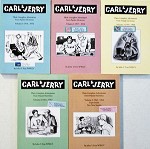Carl & Jerry: Succoring a Soroban
|
|||||||
This story reminds me a bit of the challenge thrown down by Jay Leno on The Tonight Show where he pitted a pair of Morse coders against a pair of SMSers to see who could get a predetermined script sent and received the fastest (click thumbnail to left). suc·cor noun \'sə-kər\ : something that you do or give to help someone who is suffering or in a difficult situation Carl & Jerry: Succoring a Soroban 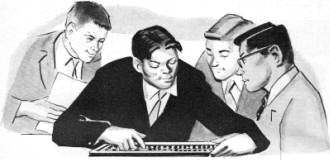 A Carl and Jerry Adventure A Carl and Jerry Adventure
By John T. Frye W9EGV
Carl and Jerry had uninvited guests in their residence hall room at Parvoo University. Bruce, a fat boy from across the hall, and a couple of his cronies had barged in a half hour earlier and showed no signs of leaving. Sprawled on his back on Jerry's bed, Bruce was holding forth: "Sometimes I wonder if Parvoo is good enough for me. My cousin at the Case Institute of Technology is one of two hundred students who have been issued personal portable analog computers by the school for use in solving differential equations and other problems in their linear systems course. The school is going to check the work of these students against that of students using only the slide rule or making occasional visits to the computer laboratory, to see how much of an advantage it is to have ready access to an analog computer at all times." "Do they issue burros to carry them ?" Carl asked sarcastically. "No need for burros. The entire computer consists of six units, each a little larger than a package of king-sized cigarettes, that can be connected in various combinations with plug-in wires. There's an adder unit, two coefficients, two integrators, and one meter control unit. The units are self-powered so that the student can use the computer while he's parked in his car or sitting out under a tree if he wishes." "How much do they cost?" Jerry asked. "First cost of the six units was $300, but it's expected that manufacturing improvements will lower this to $120. The computers were designed by Dr. James B. Reswick, Head of the Case Engineering Design Center, and James Pastoriza and George A. Philbrick. Pastoriza Electronics of Boston makes them. Get well soon, Mr. Frye...a message from Carl & Jerry Because the gentleman responsible for Carl & Jerry's electronics antics-Mr. John T. Frye, W9EGV-is seriously ill and hospitalized, there is no Carl & Jerry adventure this month. We're cer-tain that Carl & Jerry's many thousands of followers join with the entire P.E. staff in wishing Mr. Frye the speediest of recoveries. In fact, we'll be only too happy to include your "get well's" and" good wishes" with our own and for-ward the entire lot to him. So, if you want to cheer up Mr. Frye, address your cards and letters to John T. Frye, W9EGV, c/o POPULAR ELECTRONICS, One Park Avenue, New York 16) N.Y. We'll take it from there. Note: This message appeared in the February 1963 edition of Popular Electronics, one of the few times a Carl and Jerry article did not appear. See the June 1963 Carl and Jerry story for a personal note from Mr. Frye. "To use the computer, you first have to understand the physics of a system being studied. Next, you construct a theoretical model of the behavior of the system as expressed by an equation. The computer is then assembled so that it behaves in a manner identical to the system. The meter control unit displays the answer on a numbered scale and provides signals which freeze a solution at fixed time intervals, making it possible to plot numerical units accurately on graph paper. Boy, that's for me! The newest and consequently the best!" "Oh, I don't know about something new always being better," Jerry remarked as he took an object from a drawer and set it on the desk before him. It was a rectangular frame of black-painted wood about a foot long, two and a half inches high, and three-quarters of an inch thick. A narrow partition, or "beam," ran lengthwise about a half-inch down from the top. Twenty-one evenly spaced little bamboo rods passed vertically through top, beam, and bottom. On each rod four white plastic beads were strung between the beam and the bottom and one bead between the beam and the top. Each rod had enough empty spaces so that anyone bead could be moved about a quarter of an inch. "This soroban, or modern Japanese abacus, has an ancestry reaching back more than 2000 years," Jerry said; "yet when a contest was held in Tokyo a few years back between a skillful soroban operator and the most expert electric calculating machine operator to be found in Japan - he was from the disbursing department of the U. S. Army troops there - the abacus operator was an easy victor in problems involving addition, subtraction, division, or a combination of these operations. Only in multiplication problems did the electric machine win, and even then the decision was close. When you consider that this great-great-granddaddy of all computers costs only about $3.50 and that it operates anywhere with only a tiny amount of muscular energy, it doesn't stack up too badly against modern competition." Bruce heaved himself up on his elbows and looked disparagingly at the soroban. "Aw, knock it off, will you! That thing's a child's toy. The contest must have been rigged ... Do you know how to work the gadget?" he finished, his small blue eyes taking on a sly, calculating look. Jerry felt an angry red spreading over his face. Bruce had that effect on people. "I'm no expert," he retorted, "but I've noodled around enough to learn how to add and subtract on it." "Fine! Let's have our own contest. I'm no whiz at ciphering, but I'll bet I can add up a long column of four-digit numbers with a pencil and paper faster than you can on that rack of allegedly educated wampum. You game?"
"Sure. Tomorrow we can have someone add up several strings of numbers on an adding machine. Tomorrow night a judge can pick three columns of numbers at random for each of us. He can read the numbers off as fast as the person doing the adding wants. A stopwatch will determine the total time used in adding all three columns. Okay?" "I reckon so," Jerry said slowly. "Good," Bruce exclaimed as he struggled to his feet. "Come on, fellows. Let's go, and let Jerry get some practice on his counter. He'll need it." After they had gone, Jerry and Carl stared at each other. "That was a stupid thing to do," Carl observed. "You know you're a long way from being proficient on that abacus. You're lucky if you get the same answer twice when you add up a column of figures." "I know," Jerry admitted, "but something about that guy and his know-it-all attitude goads me into accepting any challenge he throws down. It takes years of practice to master the soroban; manipulating those beads rapidly and accurately is a highly developed skill. The Japanese government gives examinations and issues three grades of licenses for operating the instrument. No one starting to study the soroban after he was out of his teens has ever been able to obtain a first-grade license. And an average student has to practice faithfully for an hour each day for half a year to obtain a third-grade license. I've probably played with the thing for a total of five hours! Oh, well, maybe Bruce isn't so hot figuring with a pencil and paper." Before Carl could reply, Fred, a friend of theirs from down the hall, stuck his head in the door. "Say, Jerry," Fred said hurriedly, "I just heard about the contest tomorrow night and I thought I'd better tell you something. Bruce is a real whiz at adding figures. He won a lot of ciphering contests back in high school. I've seen him add long columns of four-digit figures almost as fast as he can write them down many a time. I've got to go now, to study for an exam, but I didn't want you walking into that session cold turkey!" "Well, that tears it," Carl declared, after Fred had gone. You and your soroban are going to look pretty silly tomorrow night. Bruce suckered you when he said he wasn't good at ciphering." "Yeah," Jerry said thoughtfully, "and that lie relieves me of any responsibility to play this thing straight. I wonder if we could dream up some way to give the soroban a little boost to compensate for an inept operator." "I can't, but you look as though you could." "Does that friend of yours in the room below us, the one whose dad is an adding machine salesman, still have that little electric machine ?" "Yeah; I saw it in his room yesterday. Don really makes that thing go." "Good, good! We'll conceal a mike and amplifier here and run a couple of small wires out our window and into his window to a speaker. Both you and he, down there in his room, will be able to hear everything said up here. When the guy reads the numbers off to me, Don can add them up on his machine." "What good will that do you?" "Remember back in high school how we used to send code to each other in study hall ?" "Sure. We used transistorized transmitters modulated with a low-frequency tone, and the receivers fed earphones buzzing against our skin." "We'll do the same thing tomorrow night. You will have a phono oscillator modulated with a keyed low-frequency tone. I'll be wearing a concealed broadcast transistorized receiver tuned to the phono oscillator and feeding a low-impedance earphone with the cap removed and the diaphragm taped directly against the inside of my leg. I'll be able to feel the vibration of the diaphragm and read the coded numbers you send."
But when Bruce and his friends arrived that evening, Jerry's heart sank. They had a stranger with them, a Japanese student Bruce introduced as Takeo Kojima. Takeo had obviously been brought along to make sure there was no faking in the operation of the soroban! But there was no time to change plans. The two boys agreed upon as judges arrived almost immediately and announced that they were ready to start. Bruce lost the toss of a coin and had to go first. He explained to the boy who was to read off the numbers that he would move his left hand when he wanted another number read. The judge started reading, the stopwatch was started, and Bruce's pencil began darting over the paper. There was a little space of time between the reading of each number and Bruce's signal to continue with the next. Obviously he was adding as he went along. This was confirmed after the reading of the fifteenth number, for he came up with the total almost immediately. In the room below, Don, who had been writing down the numbers for practice, nodded that the total was correct. And it was also correct for the next two columns of numbers Bruce added up with amazing speed. "Six minutes and five seconds total time for adding all three columns," announced the boy holding the stopwatch. "Okay, Jerry," Bruce gloated. "There's something for you and your ancient computer to shoot at. But just to make sure you don't have your desk wired for some sort of electronic hanky-panky, suppose you move over here and use Carl's. I still think it's funny he isn't here. Must be a mighty important engagement he has." Jerry agreeably moved over to the other desk, and he noticed that Takeo also changed seats, so he could watch the operation of the soroban closely. Jerry tilted the instrument toward him to slide the bottom beads down, then laid the instrument flat and ran a finger along the beam to raise the top row of beads. He nodded to the judge that he was ready. As soon as the judge finished reading one number, Jerry slapped his left hand on the table to indicate he was ready for the next. At the same time, he kept flipping the beads of the abacus aimlessly with the thumb and forefinger of his right hand. Without looking, he could sense that Takeo was watching every move. Suddenly the fifteenth number was given, and the judge said, "Add!" Quickly Jerry cleared the abacus and began setting up the numbers he felt vibrating in dots and dashes against the flesh of his leg. "Fifty two thousand five hundred and three!" he read aloud. "Correct," the judge answered; "go ahead with the next column." The addition of the next two columns was a repetition of the first. Jerry left much less time between the reading of the numbers than had Bruce, and he came up with the total almost as quickly. "Three minutes and forty seconds total time," the judge with the stopwatch announced. "I guess there's no doubt about the winner." You can't buy a soroban from the original source anymore; however, you can still buy one on Amazon. Please click the image for more info. "Now comes the exposure!" Jerry thought as he braced himself and looked up at Takeo; but the Japanese was smiling at him in admiration. "Let me congratulate you," he said, holding out his hand. "I studied the soroban in school, and at first you puzzled me with your unorthodox manipulation of the beads; but then I realized what you were doing: you were using mental calculation, the method of the experts! "You see," he explained to the others, "this is a method in which the operator simply visualizes a soroban and mentally manipulates the beads as each number is added. It is extremely fast because the whole operation takes place in the brain cells. I realized that Jerry was using this method when I noticed he was actually not recording the numbers read off on the physical soroban in front of him; yet, when it was time for the total, he racked it up correctly on the instrument." Why didn't you tell us you were an expert ?" Bruce demanded as he headed angrily for the door. "You did a little holding out yourself, didn't you ?" Jerry retorted. Shortly after the others left, Carl and Don, grinning from ear to ear, came into the room. "Boy, that was close!" Carl exclaimed. "I thought we'd had it when they introduced that Japanese fellow." "I know," Jerry agreed, and then went on to admit, "I still don't feel quite right, though, about resorting to trickery to win." "Neither do I," Carl confessed; "but I console myself by thinking it could not have happened to a more deserving guy than Bruce!" If you're interested in getting a soroban (often called a "Japanese abacus") like the small 13·reed one shown above, Charles E. Tuttle Co., Inc., Rutland, Vt., will sell you one for $1.25. A medium-size, 15·reed unit costs $2.75, and a large 23·reed soroban $3.25. Also available (for another $1.25) is a paperback book titled "The Japanese Abacus - Its Use and Theory." When you order, enclose 25 cents extra for postage for each soroban and book. And when you order, say "Carl and Jerry sent me."
Posted October 25, 2020
|
|||||||

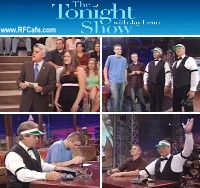
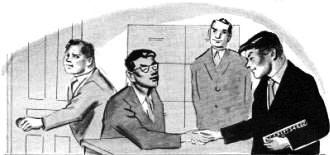
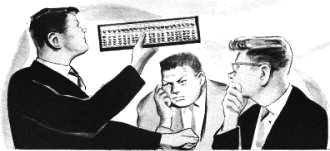
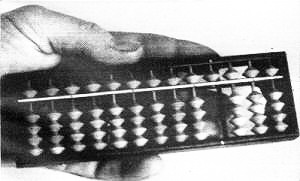

 Carl & Jerry, by John T. Frye
Carl & Jerry, by John T. Frye